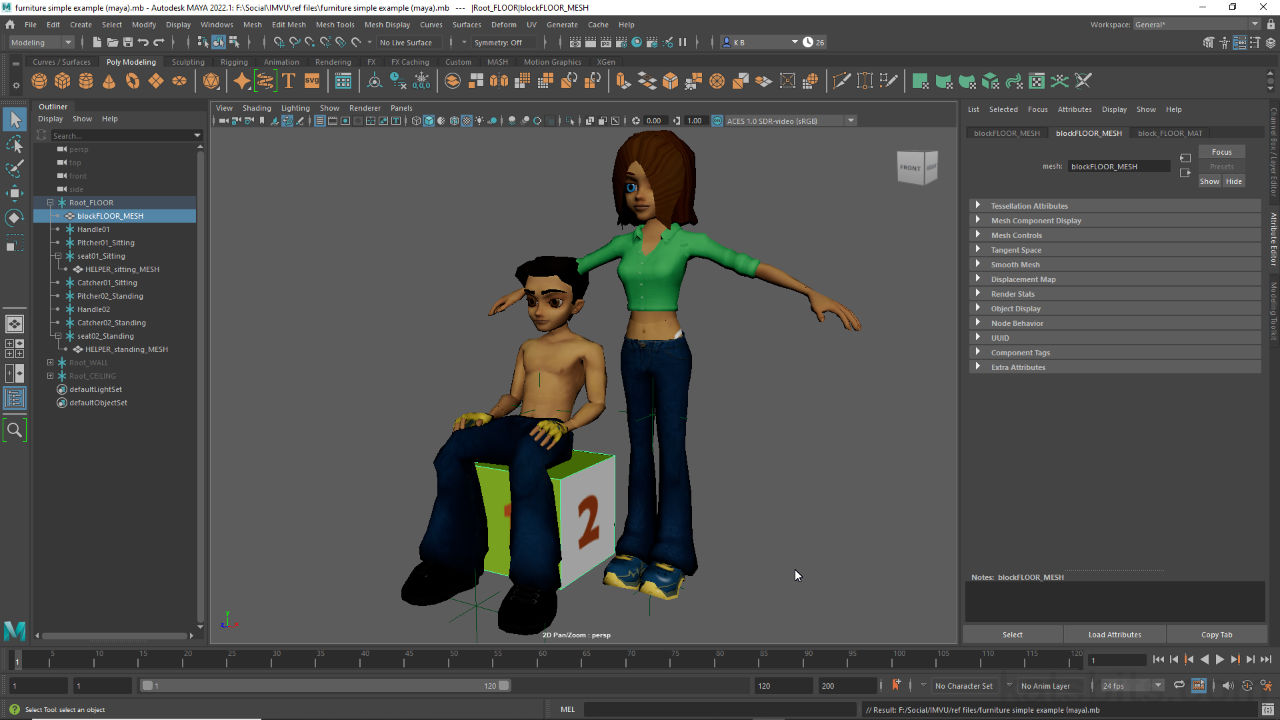IMVU Furniture Basics for Maya
Table of Contents
Description
With the advent of support for FBX it’s now possible to make products for IMVU using Autodesk Maya, the process being much the same as it is for Blender and 3DS Max. With this in mind the video tutorial above runs through the basic process of opening a Maya Furniture Starter File into the application to explain the basic prep and set up required to successfully export an FBX from Maya, and import, with a little editing of the XSF file produced during assembly, in IMVU Studio.
Duration: c. 17 mins (17:00).
Info: 1080p | c. 80 MB.
Source: KatsBits – Maya Furniture Example (zip c. 700 KB – *.mb, *.png, *.jpg).
Design note: when setting up the furniture item, Root (a Locator object in Maya) should be positioned and rotated relative to the type of product the User interacts with, floor, wall or ceiling. In practice this means the Root nodes Translate coordinates should be 0.000 for each Y, Z and X axis, with the Z axis generally pointing upwards for floor items, inwards for wall, and downwards for ceiling mounted items – that’s -90° around the X axis for floor, 0° for wall and 90° for ceiling.
Important: the rotational coordinates mentioned here relate to how IMVU determines an objects origination in the Client not necessarily how the item might be built, in other words it is not specifically necessary to build a mesh upside down for ceiling items so long as the object is made with its eventual placement in mind.
Furniture items should be positioned so Root [1] sits as grid centre [2], any meshes being built around it relative to their in-game function (floor, wall, ceiling), i.e. Translate at 0.000 for each X, Y and Z axis.
Furniture uses the Z axis to define orientation so for floor mounted items Z [3] points upwards from the grid, i.e. -90° [4] (negative 90) around the X axis.IMVU uses a much larger scale than Maya’s defaults so files not previously prepared for use may appear extremely large and clip the scene camera. To address this, in Settings [5], make sure the Working Units is set to meter [6], and Far Clip Plane to at least 5,000 to 10,000 ‘units’. For more on setting up Maya for use with IMVU see here.
Setting up Maya to accommodate IMVU’s much larger scaling, making sure Linear is meter [6] and Far Clip Plane is between 5,000 and 10,000 at least [7].During export from Maya using FBX enable Smoothing Groups and Smooth Mesh [8] as a minimum (if not active) to ensure meshes appear correctly shaded in IMVU (this is especially important where Normal and Shininess maps are used). Enabling or disabling other settings will then be determined by the type of item and functionality provided, i.e. enabling Animation where the item animates, disabling Cameras and Lights to exclude where not used, and so on.
The default options for exporting FBX from Maya [8] may need modifying depending on the type of item being exported and the functionality included, animation, lights, cameras etc. At a minimum enable Smoothing Groups and Smooth Mesh to ensure proper in-game shading of the mesh.
Timestamps
Times are approximate.
Video : IMVU Furniture Basics for Maya – c. 17 mins (17:00).
– 00:00 : Scene Set Up/Item Prep.
– 03:30 : FBX Export & Studio Import (1).
– 06:00 : Adding Seats/Pose Spots.
– 09:30 : FBX Export & Studio Import (2).
– 13:00 : Editing XSF file.





